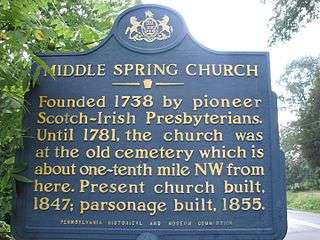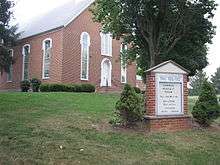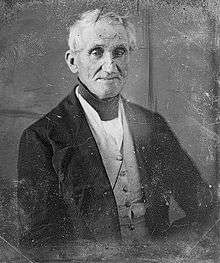Middle Spring Presbyterian Church
The Middle Spring Presbyterian Church was first built in 1738 by some of the earliest Scotch Irish settlers in Pennsylvania, and is much discussed in the histories of early Pennsylvania in general and Cumberland County, Pennsylvania in particular.

Scotch-Irish Settlers
Middle Spring Presbyterian Church is located in Cumberland County, Pennsylvania in the small community of Middle Spring, Pennsylvania on present day Pennsylvania State Route 4001 (old Pennsylvania 696), two and six-tenths miles north of Shippensburg, Pennsylvania. A group of Scotch Irish immigrants settled in this area in about 1730. The Scotch Irish were the earliest settlers on the Pennsylvania frontier of the early 18th century. As one author puts it:


The Cumberland Valley was dotted with Scotch-Irish settlements throughout its entire area, a district which had become almost exclusively the possession of this racial group, with whom were mingled small numbers of English and German settlers constituting perhaps ten percent of the population. It was well adapted to farming, and the Scotch-Irish, in this early period, were mostly farmers, but later they developed a marked aptitude for trade and the professions.[1] As pioneers, they advanced onto land that had not previously been colonized by Europeans. On the frontier, they participated in the Indian wars, and experienced the hardships of pioneer life as was typical of frontiersmen in provincial Pennsylvania. They pushed further and further into the interior of the country.[2]
Founding of the Church

In those days, the Middle Spring area was very much a part of this rugged frontier, where Indian attacks were common. Many of these early settlers fell victim to these attacks. These immigrants brought their Scotch Presbyterian origins with them.[3] Presbyterian preaching began on this site in the open air as early as 1736. These settlers erected a Presbyterian Church building at this Middle Spring site in 1738, close to the bank of the small Middle Spring creek that ran through the area. The pioneer Scotch-Irish settlers in the Cumberland Valley almost always built their churches near streams and springs to have available an abundant source of water. The first building was a log church, which became not only a house of worship but a gathering place for the early settlers in the area.[4] There are two other springs in the area – Big Spring and Rocky Spring. They called the church site "Middle Spring", because it was located midway between the Big Spring and the Rocky Spring.[5] The church was thirty-five feet square. It had slab benches, a dirt floor and was unheated. The pulpit was high and was set against the wall. The precentor's desk was positioned right below and in front of it.
Attending the Frontier Church

Prolific local historian, Belle Swope writes the following about her family members, Robert Quigley and his wife, Mary Jacob Quigley, who were among the early members of the Middle Spring Presbyterian Church at a time when it still held services in the very wild frontier of backwoods Pennsylvania.
[Robert and Mary Quigley] were members and regular attendants of the Middle Spring Presbyterian Church, which his parents were instrumental in organizing. Many members who were compelled to ford the creek, were irregular in their attendance, the stream at times being impassable, but not having the inconvenience of crossing the creek, he and his family were rarely absent from worship. The first minister was Rev. Thomas Craighead (1737–39). [Robert and Mary Quigley] sat under the preaching of the Rev. John Blair (1741–56) who succeeded Rev. Thomas Craighead, Rev. Robert Cooper from 1765 to 1797, and Rev. John Moody D. D. who began his pastorate in 1803 and continued in charge of the congregation for nearly 52 years. Their neighbors and friends attended the same church, and the Sabbath was a day of pleasant reunion as well as a season of worship. In the early days of the settlement, a peaceful frame of mind was not enjoyed by the worshiper, for the fear of an Indian outbreak was the prevailing thought in each heart, but gradually their outrages subsided, and muskets were no longer stacked at the church door, nor did the anxious eyes of the family as they returned to the home scan the horizon for a flame or a curl of smoke, that might be the last of what was once their fireside, built by their hands.[6]
Original Church Replaced
The parishioners replaced the first log church with another in the 1760s. In turn, they replaced this church with the "Old Stone Church" in 1781. However, it suffered from a "structural defect". So, the congregation had to tear it down and replace it in 1847. At that time, they moved the church from where the old cemetery is still located (about one-tenth mile to the northwest) to its present location. A Christian Education Building was added to the 1847 sanctuary in 1964. There are four cemeteries associated with Middle Spring Church: the Lower Cemetery, the Upper Cemetery, and the Modern Cemetery;Hannah's Cemetery is locateds outside of Newburg.[7]
Famous Members

Many of the original settlers of Cumberland County are buried in the Middle Spring Presbyterian Church Cemeteries.[8] Among those buried there are Hugh Brady and Hannah Brady, parents of Major John Brady (whose many exploits on the Pennsylvania frontier are commemorated in a monument in Muncy, Pennsylvania). They are also the grandparents of John's sons, Captain Samuel Brady, of Brady's Leap fame and of Samuel's brother, United States Army Major General Hugh Brady, both of whom attended this church.[9] Their maternal grandparents James and Jeanette Quigley are buried there as well.{ A detailed modern history of Middle Spring Presbyterian Church is available in Paul E. Gill, Ye People of Hopewell: A 250th Anniversary History of the Middle Spring Presbyterian Church,(Shippensburg: 1988).}
References
- Wayland F. Dunaway, The Scotch-Irish of Colonial Pennsylvania; University of North Carolina Press, 1944, p. 60.
- Dunaway, p.70.
- "History of Middle Spring Church". Archived from the original on 18 November 2008. Retrieved 12 August 2008.
- History of Middle Spring Presbyterian Church, Middle Spring, Pennsylvania 1738–1900, Belle McKinney Hays Swope, Newville, Pennsylvania, Times Steam Print House, 1900, Preface, pp. 32,107.
- Early History of Shippensburg Archived 19 July 2011 at the Wayback Machine
- Mrs. Belle McKinney Hays Swope, History of the Families of McKinney-Brady-Quigley, Newville, Pennsylvania., Chambersburg, Pennsylvania., Franklin repository printery, 1905, pp. 230 et seq. A copy of this book is held by the State Library of Pennsylvania, Call number 929.1 Sw77."
- http://www.middlespringpc.org/about
- Middle Spring Presbyterian Cemetery
- General Hugh Brady was born in Standing Stone, Pennsylvania, which is now Huntingdon, Pennsylvania on 27 July 1768. However, he did attend that church at points in his life. Both his parents had been brought up in the Middle Spring Presbyterian Church and his mother, particularly, was very religious. So, any time Hugh lived in the vicinity of this church, he would have attended it. With that in mind, his sister, Agnes Brady was born on 14 February 1773 in Cumberland County, Pennsylvania, which indicates his parents were living there at the time of her birth. The Indians killed his father on 11 April 1779 when they were living near present day Muncy, Pennsylvania. After the death of her husband, his mother Mary Quigley Brady took her still at home children, which included Hugh, to live with her brother Robert Quigley, who attended the Middle Spring Church all his life and is buried in its Upper Cemetery. She stayed with Robert Quigley until October of that year, when she returned to her home near Muncy. Four of Hugh Brady's children were born in Cumberland County, Pennsylvania, Mary Luthy Brady on 11 November 1811, Elizabeth Hall Brady on 31 October 1814, Jane Brady on 10 March 1817 and Cassandra Brady on 18 August 1819, which indicates that he lived there during that time period. Brady Genealogy